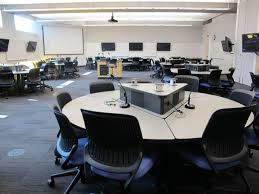Active learning is popular in the education research community right now. According to the University of Michigan Center for Research on Learning and Teaching, active learning is a “process whereby students engage in activities, such as reading, writing, discussion, or problem solving that promote analysis, synthesis, and evaluation of class content.” This mode of teaching and learning stands in direct contrast with traditional lecture-style learning, which tends to take place in a lecture hall. The spaces in which the learning takes place are important but the environment of the class is far more important. Active learning environments are centered on students learning by doing, whereas traditional learning environments are centered on the passage of knowledge one way from the instructor to the students. Universities are investing vast resources into constructing classrooms specifically to facilitate active learning environments, often with round tables, whiteboards, and technology tailored to meet the needs of an active learning classroom.
The question: is the investment worth it? According to a 2014 study published in Life Sciences Education, the answer is a resounding yes — especially for black and first-generation college students. The researchers implemented a “moderate-structure” change in an undergraduate Biology course, which effectively meant turning the course into an active-learning environment. They found that the performance of all students clearly increased versus a traditional Biology course. This performance increase was especially pronounced in black students and students in the first generation of people in their family to attend college, for whom the achievement gap was halved. The New York Times quoted researcher Kelly A. Hogan, “In a traditional lecture course, [students are] not held accountable for being prepared for class, and they don’t really need to be, because an instructor is going to tell them everything he or she wants them to know. Would you read a report for a meeting if you knew your boss was going to spend 15 minutes summarizing it for you? I know I wouldn’t.” This gets at the main difference between active-learning and traditional classrooms: it levels the playing field by providing for ample in-class and out-of-class engagement with the material, which deepens understanding. The students in the classroom community depend on each other and the learning is more distributed.
Another recent article in the New York Times, entitled “Are College Lectures Unfair?”, examined the inherent biases of the traditional lecture against “undergraduates who are not white, male and affluent”. All students do better in active learning classrooms than in traditional classrooms, but those who are not upper-middle-class white men show significant improvements. This could be due to the active-learning classroom’s tendency to mitigate stereotype threat, a measured phenomenon that affects groups for which there is a stereotype about their abilities and aptitudes in certain tasks or activities. For example, a famous study of women in math classes found that when women are reminded of the stereotype that women are bad at math they perform far worse on math tests than women who are not reminded of this stereotype. Similar research has demonstrated the same effect in black college students and marginalized groups. One of the main advantages of the active learning classroom over the traditional lecture classroom is that it mitigates the damage of stereotype threat. By constructing an interconnected learning community, active learning classrooms level the playing field without sacrificing the performance of those who are usually high performers.
Where does Georgia State University (GSU) fit into the active learning movement? Georgia State has had remarkable success in the education of students who are typically the least served in higher education as a whole. As one of the most diverse research institutions in the United States, GSU confers more degrees to students of color than any other institution in Georgia. Georgia State’s student body is nearly two-thirds non-white; 30% of students at GSU are in the first generation in their family to attend college and 56% of students receive Pell Grants, which are awarded to students from low-income backgrounds.
Georgia State recently took some actions designed to increase its graduation rate, which directly benefited its most vulnerable students. A 2013 article in The Atlantic examined in depth the specific actions that Georgia State has taken, which has been successful in raising the graduation rate by 22 percent in recent years. These actions include peer tutoring and Supplemental Instruction, among other active learning interventions. Many GSU departments including the Center for Instructional Innovation are designing innovative active learning classrooms and building spaces to accompany these types of changes. As the University moves away from traditional lectures and toward active learning classes, it has the unique opportunity to help students succeed by becoming a leader in the active learning movement.


